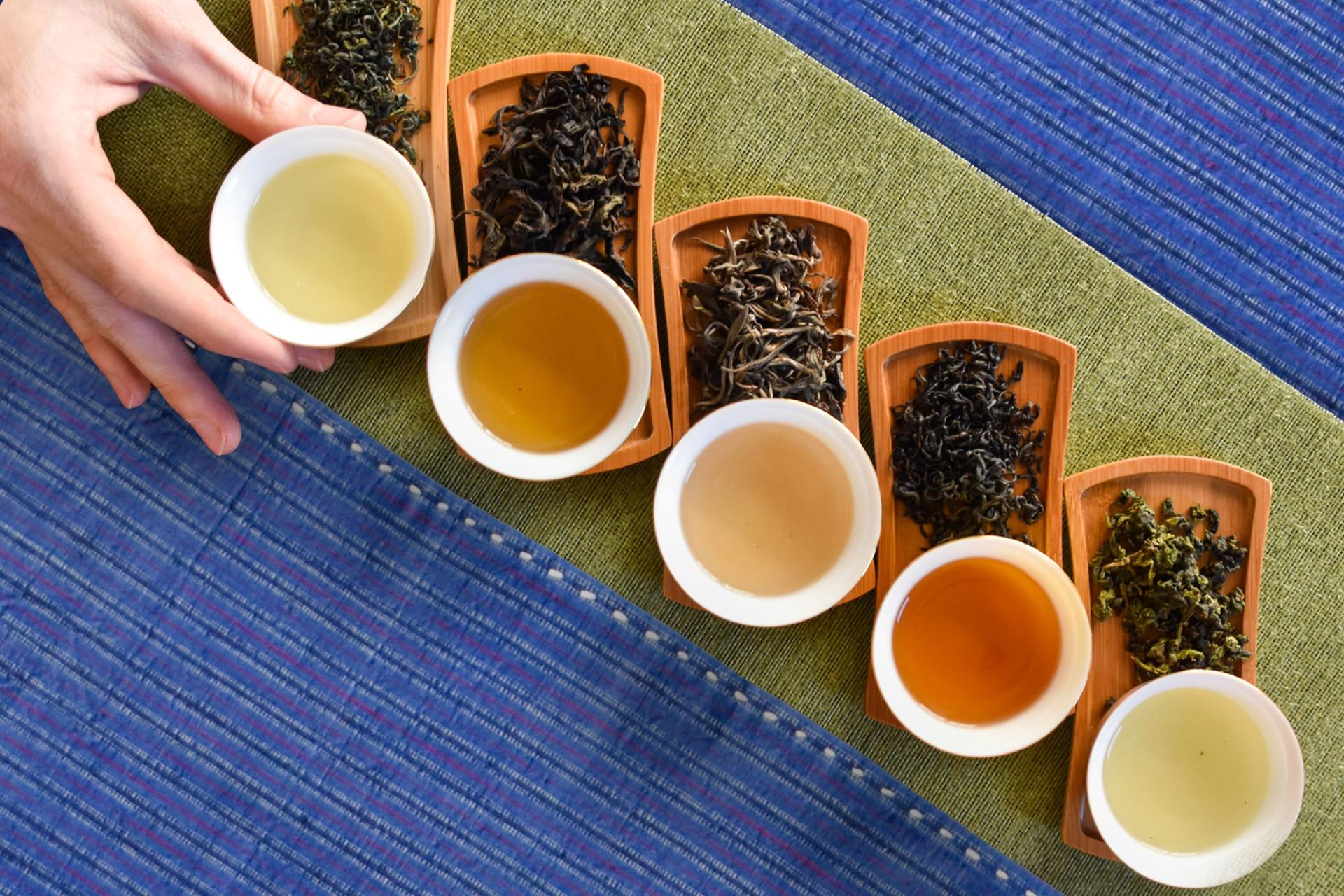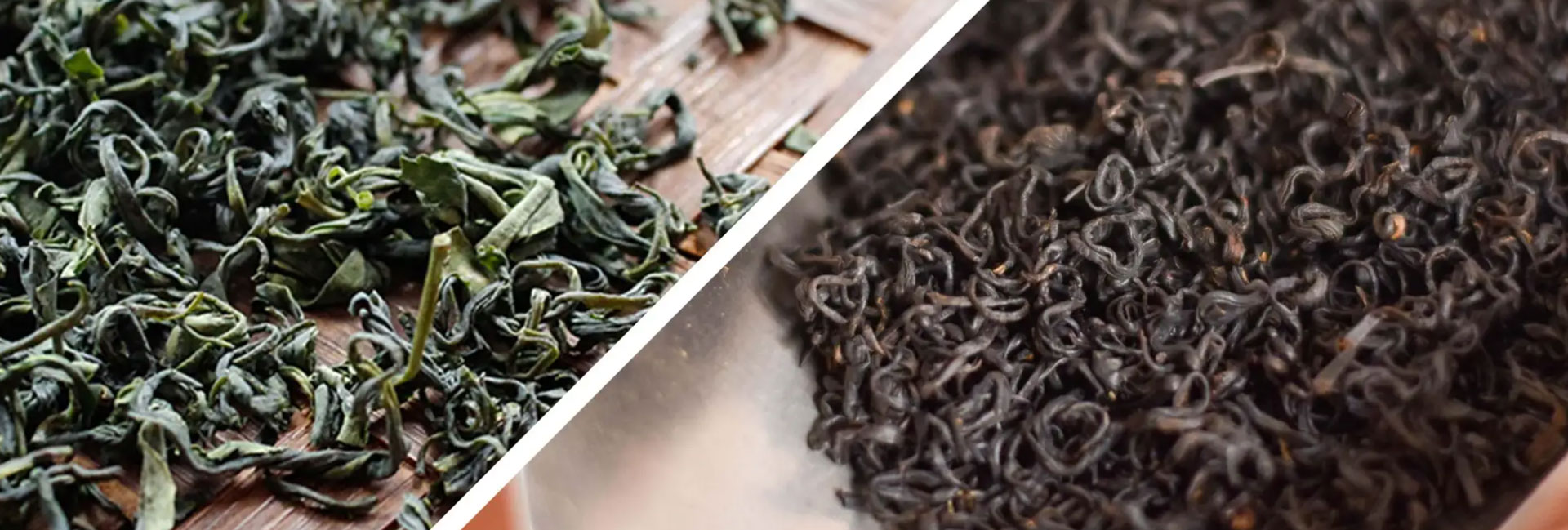Are you comparing black tea vs green tea and looking to know more about what makes these iconic styles unique?
In this article, we’ll be getting to know what defines these two tea styles and sharing what makes for the best green tea and black tea in the world.
Here’s a big question:
is black or green tea
better for you?
The question might seem simple, but it’s hiding a more important point.
WANT FREE TEA?


Sign up to get tea deals,
fun tasting journals and more
tea education with our special
Daily Deal Tasting Journal.
We’ll thank you with
a gift of free tea!
When it comes to health benefits and flavor, there’s far too much hype out there working to create anxiety about making the right choice. There’s not nearly enough consideration about where and how these teas are grown.
Let’s take a look at the big picture. Both green tea and black tea can be sweet, beautiful, healthy and aromatic, but only when craft, agriculture and sourcing are done right.
Differences Between Green Tea and Black Tea (and Similarities)
Where does green tea come from? What about black tea? Green tea and black tea do not come from different tea plants. Instead, green tea and black tea are defined by the way they are finished in the workshop.
Green tea finishing is all about locking in the flavor and aroma of fresh-picked tea leaves, while black tea is all about bringing out sweet, dark and malty qualities.
Despite the difference between black and green tea, both teas have a lot in common:
-
• They are both made from the same plant: Camellia Sinensis var sinensis
-
• Both green tea and black tea require heat finishing to lock in their unique flavors
-
• No matter how a tea is finished, the tea plant itself thrives in biodiverse mountainous landscapes. That’s why both green tea and black tea taste best when grown without chemical intervention.


Where They Are Grown
A tea’s quality is defined by the environment where it grows and the craft of the producer. While a region making green tea can also make black tea, in the real world, regions tend to specialize. Much of the flavor we associate with green tea vs black tea comes from the specific regions where these teas are most popular.
In China, for example, these regions are famous for producing certain types of tea:
Green Tea:
Black Tea:
Each of these regions gives unique flavor to their tea based on their weather, surrounding environments, local traditions and more.
For example, in Yunnan, tea can grow wild in ancient tea forests. This biodiversity contributes to a more complex black tea brew. In Shi Feng Dragonwell, the local sweet spring water and unique weather make for a particularly delicate green tea. In contrast, too much sun can lead to bitter tea, while weak tea can come from poor-draining soil or improper storage. Growing black tea and growing green tea both require biodiverse, cool, shaded environments to bring out the best in each style.
Processing
The difference between green tea and black tea is all about processing. You can taste the same tea leaves picked on the same day by the same family but try one green tea and one black tea. A good example of this is the He Family in Laoshan that produces Laoshan Green and Laoshan Black every year. So how is green tea made compared to black tea?
-
• Green tea is heat-fixed after a short withering step to prevent oxidation
-
• Black tea is allowed to oxidize fully in higher heat and moisture conditions before heat-fixing
-
• Black tea is often fired after heat fixing for a more roasted quality while green tea is dried using much lower heat to preserve its delicate aroma.


How They Are Prepared
The great thing about fine tea is that all the hard work is done in the fields and in the workshop. Brewing green tea and black tea is flexible, and your tea should taste good no matter what.
The biggest difference between green tea and black tea brewing? Green tea is usually infused at a lower temperature to protect its sweet delicate qualities, and black tea is usually brewed with water at full boil for big flavor. There is no hard and fast rule, but if you want to explore all the options, we’ve got a full brewing guide here.
One of our favorite techniques is the simple “leaves in water challenge.” Any good tea should taste great simply by adding leaves to a mug and topping it off with boiling water throughout the day.
Taste and Appearance
Distinctive craft and growing regions means that green tea vs black tea taste very different from each other. You can spot the difference at a glance, and confirm your guess from the aroma alone. No matter the growing region or precise finishing style, all green tea and black tea can be distinguished by some easy “tells”:
-
• Green tea leaves are green in color. Black tea is dark red-brown in color. The only ‘trick’ is if you look at very old green tea, it can be closer to black as it oxidizes over time.
-
• Green tea smells vegetal, while black tea smells sweet and malty. Any green tea should have a ‘fresh’ smell like sweet grass, and herbaceous complexity. Black tea smells more chocolatey and dark.
-
• What does black tea taste like? Black tea should be malty sweet and rich, with a reddish color. Green tea should be aromatic and vegetal with a light green color.
Does Green Tea or Black Tea Have More Caffeine?
It turns out that caffeine depends on a lot more than finishing style. Caffeine is going to be tied to how fresh the tea is, when it was picked, and exactly how you brew it.
Looking for non caffeinated green tea or black tea options? Learn about tisanes made using tea finishing techniques.
Benefits of Black Tea vs Green Tea
So, is black tea or green tea better for you?
Black tea and green tea’s health benefits are much more closely related to the environment where the tea grew, and how fresh it is than whether the leaves were finished as green tea or black tea.
For peak antioxidants, look for teas grown without pesticides on biodiverse small family farms, picked at peak freshness and stored properly.
But what’s the healthiest tea? The one you like to drink the most!
Any tiny differences in benefits are outweighed by the fact that you have found a tea you want to drink more often.
Benefits of Black Tea
The difference between green tea and black tea is all about processing. You can taste the same tea leaves picked on the same day by the same family but try one green tea and one black tea. A good example of this is the He Family in Laoshan that produces Laoshan Green and Laoshan Black every year. So how is green tea made compared to black tea?
-
• Black tea has a longer shelf life than green tea. Black tea stays flavorful for several years while green tea fades much faster.
-
• Black tea flavor stands up to milk. Black tea is the most popular base for spiced chai and milk tea thanks to its robust flavor.
-
• Black tea is easier to brew. Because they are less delicate, black tea leaves are harder to oversteep.
Benefits of Green Tea
Is green tea healthier than black tea? It all depends on whether it is fresher, grown more responsibly, and made from more tender leaves and buds. Green tea is all about fresh seasonal harvests- the excitement around fresh harvests feels like a festival every year in China. What’s the big deal?
-
• Green tea is heat-fixed after a short withering step to prevent oxidation
-
• Black tea is allowed to oxidize fully in higher heat and moisture conditions before heat-fixing
-
• Black tea is often fired after heat fixing for a more roasted quality while green tea is dried using much lower heat to preserve its delicate aroma.
Shop High Quality, Responsibly Sourced Black and Green Teas from Verdant Tea
Both green tea and black tea at their highest levels are inspiring and beautiful to taste. They are invitations to get to know a growing region and the style of an individual farmer-family. In some exciting cases, you can taste green tea and black tea from a single region and family to see how much craft influences the final brew. When you are drinking the best green tea and black tea you can taste the difference, and enjoy the benefit of clean agriculture, and biodiverse growing regions.
Want to dive deeper? Experience is the best instruction. See and taste the difference for yourself with a tasting kit comparing the very finest green and black teas out there.


Taste teas from six unique growers and six regions - premium hand-picked teas, direct from the farm.
Six kinds of tea & Six passionate growers - these are the iconic classics that represent what we and our partner growers stand for: true sustainability, transparency, and the taste and aroma that come from the impeccable terroir and craft of the best growers in China.
$48.95 $44.06
Thousands of years ago, there was not a word for “tea.”
When Camellia sinensis (tea) was first used in Chinese medicine, it was referred to as tu (荼), the same word used to generally describe any medicinal plant. Only when craft and ceremony started to surround tea in the Han dynasty did the plant get its own specific character (茶)cha. In recognition of its cultural importance, there was a deliberate attempt in the language to elevate tea. At this point, diverging craft and tradition separated teas as unique and distinct from other herbs that would have been dried or eaten directly.

Today, the weight of that distinction is a line in the sand between the simpler herbal teas – picked, dried and steeped out in large pots – and the “real” tea, Camellia sinensis, that requires meticulous finishing and craft at every stage and has inspired an entire aesthetic culture of teaware, ceremony and tasting.
For many of us, this line is clear. It seems easy enough to say that “real” tea is Camellia sinensis while herbal tisanes encompass everything else.
 Here’s the problem with that distinction.
Here’s the problem with that distinction.
By putting all the cultural value that the word “tea” inspires behind one species of plant, we are missing the opportunity to appreciate the craft, devotion and subtle taste experience that can bring out beauty in other plants.
I’d like to submit to the tea community at large that the cultural weight of the word tea should be awarded based not on plant species, but on craft. After all, it was the craft of tea that originally made it necessary to distinguish 茶 and 荼.
It is rare indeed to find those herbs and flowers whose craftsmanship and finishing are as meticulous and intensive as Camellia sinensis. Most herbal teas are made with ingredients that are picked and then air dried without heat-fixing, curling, roasting, fluffing, aging or any of the other processes that make tea so beautiful.
Yet, there are exceptions to the rule, exceptions that are so stunning that they make me completely rethink the way I use the word tea. These exceptions are coming from two of our closest partners in China, the He Family in Laoshan, and the Dongsa Cooperative in Qianjiazhai.
The He Family lives at the foot of the Laoshan mountains, a protected parkland full of wild herbs. For years, He Qingqing’s mother has been a devoted herbalist wild-foraging medicinal herbs like Goji Leaf, Jujube Leaf, Mulberry Leaf, Huai Flowers, and even Dandelion Leaf.
She used to dry these herbs to brew as fortifying tonics for those long days in the workshop and in the fields picking and finishing her family’s stunning teas. Yet, in the last few years, the He Family has been taking these much further, experimenting in their workshop by taking the fresh leaves and flowers and giving them the same treatment as their teas.

All of these “non-tea” leaves are spread in bamboo baskets to wither, quickly heat-fixed to lock in their flavor and efficacy, curled to bring out deeper complexity (breaking down plant cell walls and creating a light oxidation effect), and finally, dried over controlled heat in woks and tumblers to bring moisture down to about 3% as quickly as possible. This last step prevents hydrolysis reactions from changing the flavor and keeps the finished leaves food safe and shelf stable. The heat and finishing that the He Family bring to their herbs locks in a different portrait of these herbs’ natural flavors, bringing out their sweetness, eliminating bitterness, and coaxing out their hidden complexities.
Over hundreds of years, people realized that tea was sweeter and more delicious with processing than it was fresh or simply dried. Now, this insight being applied to other herbs by people like the He Family. The results are what I would argue go beyond our understanding of herbal teas and instead cross over into what should rightfully be called “real” tea.

The Dongsa Cooperative in Qianjiazhai is so remote that a generation ago even their Camellia sinensis var. assamica was too undervalued to be worth picking any more than staple food crops. In only the last few decades, the demand for their wild-forages ancient tea tree pu’er has skyrocketed as the domestic market realizes what a rare opportunity teas from Qianjiazhai really are. This means that the craft of tea is still new, and still being taught and shared with new craftspeople across the area by community leaders like Master Zhou.
This living memory of perhaps the last region on earth that hadn’t yet truly drawn a value difference between cha and tu means that people here are much more open-minded about finishing techniques and more respectful of all the plants that they can forage.
This open-mindedness has led to an “herbal” tea awakening in the area, with distant caffeine-free tea relatives like Camellia crassicolumna being wild-foraged, withered aged, and pressed into cakes just like sheng pu’er picked from Camellia assamica trees. The result is that over the last few years, demand for wild crassicolumna has begun to exceed demand for “real” tea.
Indeed, with its long aftertaste and sweet, rich texture, Crassiclumna is just as nuanced and complex as “real” tea. The devotion that Master Zhou, the Li Family and the whole cooperative put into foraging for this plant and carefully finishing it is at least equal to their “traditional tea.” So if pu’er (made from Camellia sinensis var. assamica) can be called tea, why not its cousin, Camellia crassicolumna?

The He Family and the Dongsa Cooperatives’ wild-foraged experiments are limited and highly seasonal, but they might be new a blueprint for herb farmers across the world.
Why should any small farmer going through the labor of tending their fields and the craft of balancing their agriculture have to have their product treated like an auction commodity, no different from the next field over? Why should mint farmers or tulsi farmers be denied the chance to offer something that goes beyond the commodity market and in doing so, creates a more economically sustainable model?
The introduction of finishing craft is a path forward towards this vision, a way for small farmers to tap into the culture of tea and offer the world something new and beautiful. We look forward to seeing what the future brings!


 How To
How To Myths & Legends
Myths & Legends Travelogue
Travelogue Tasting Journal
Tasting Journal Talking Shop
Talking Shop Tea 101
Tea 101 Watch
Watch Teaware
Teaware News
News




 Here’s the problem with that distinction.
Here’s the problem with that distinction.
Leave a Reply